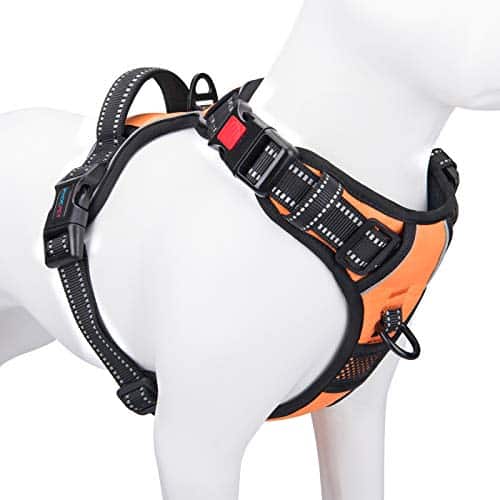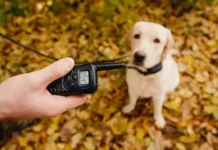If you’re a dog owner, one of the most important decisions you have to make is choosing the right harness size for your pet.
It’s not just about looking good – the wrong size can cause physical discomfort and even harm your pup.
When selecting the perfect fit for your furry friend, it would be best to consider a few things.
This blog post will discuss how to measure your dog for a comfortable fitting harness and provide tips on choosing the right size.
Read on to learn more about finding the perfect fit for your pup!
Measuring Your Dog for a Harness
When finding the right size harness for your dog, measurement is key.
The last thing you want is for your dog to be uncomfortable in their harness, or for the harness to be too loose and risk coming off. Here’s a step-by-step guide on how to measure your dog for a harness:
First, you’ll need a flexible measuring tape. Start by measuring around your dog’s chest, just behind the front legs. Make sure to keep the tape level all the way around. Once you have that measurement, refer to a size chart to find the corresponding harness size.
You can use a string or rope if you don’t have a flexible measuring tape. Wrap it around your dog’s chest and measure the length with a ruler or yardstick. Again, refer to a size chart to find the right harness size.
Once you have your dog’s measurements, it’s important to consider its weight and body type. If your dog is on the smaller side but has a broad chest, it may need a larger harness than its measurements indicate.
Likewise, if your dog is on the larger side but has a slim build, it may need a smaller harness. Use your best judgment when selecting a size, and always err on the side of caution if you’re unsure.
Now that you know how to measure your dog for a harness, it’s time to start shopping!
The Different Types of Dog Harnesses
Small dog breeds:
Toy and teacup breeds like Chihuahuas, Yorkshire Terriers, and Pomeranians typically need a harness that fits around their chest and belly. This type of harness is often adjustable to ensure a comfortable, snug fit.
Medium dog breeds:
Breeds like Cocker Spaniels, Beagles, and Border Collies do well with a medium-sized harness that wraps around their chest and back. This size is also adjustable to provide a custom fit for your pup.
Large dog breeds:
Giant breeds like Great Danes, Mastiffs, and Saint Bernards need a heavy-duty harness to handle their size and strength. These harnesses have wide straps that distribute weight evenly and won’t rub or chafe your dog’s skin.
How to Put on a Dog Harness
Putting on a dog harness may seem daunting, but it’s simple! Follow these easy steps, and you’ll have your pup all harnessed up in no time.
1. First, find the right size harness for your dog. If you’re unsure, consult a sizing chart or take your dog to a pet store to try on a few different options.
2. Once you have the right size harness, put it on your dog like a coat or jacket. The straps should go over your dog’s shoulders and around its chest, and the buckle should be fastened securely at the back.
3. Finally, adjust the straps to ensure a comfortable fit. You should be able to slip two fingers under the straps near your dog’s collar for the best fit. And that’s it! Now you’re ready to hit the road with your four-legged friend.
What happens if a dog harness is too big?
If a dog harness is too big, it can be uncomfortable for the dog and may cause the harness to slip off.
A too-big harness can also make it difficult for the owner to control the dog.
How do I know if my harness is too small?
If you are unsure if your dog’s harness is too small, there are a few key things to look for. First, ensure the harness is tight around your dog’s chest.
You should be able to fit two fingers under the harness straps. Ensure the harness does not rub or chafe your dog’s skin. The harness is likely too tight if you notice any redness or discomfort.
Finally, ensure your dog can comfortably move in their harness. They should be able to walk, run, and play without restriction.
It is likely too small if you notice your dog struggling or appearing uncomfortable in their harness.
At what age does a dog need a harness?
Harnesses are an important safety tool for dogs of all ages, especially for puppies and seniors.
Puppies need a harness to help them learn not to pull on their leash, and senior dogs need a harness to help them avoid injuries from pulling on their leash.
Many types and sizes of harnesses are available, so choosing the right one for your dog is important. The best way to determine what size harness your dog needs is to measure them.
Do vets recommend collars or harnesses?
There are various factors to consider when choosing between a collar or harness for your dog, and ultimately the decision comes down to personal preference.
That said, many veterinarians prefer harnesses over collars, as they offer more control and distribute weight more evenly around the dog’s body.
If you’re unsure which option is best for your pup, consult your vet.
How do you measure for a harness?
There are a few things to consider when measuring for a harness:
- The size of your dog’s chest
- The size of your dog’s neck
- The type of harness you are looking for (i.e. adjustable, step-in, etc.)
To measure your dog’s chest, wrap a tape measure around the widest part of its chest and record the measurement. For their neck, do the same thing but at the point where their neck meets their shoulders.
Once you have those measurements, you can consult a sizing chart for the specific type of harness you are looking at to find the best fit.
Or, if you’re unsure, most brands offer customer service that can help you find the right size.
Should a dog harness be tight or loose?
When choosing the right size harness for your dog, one of the most important factors is how tight or lose the harness should be.
There are a few different schools of thought, so it’s important to research and decide what’s best for your dog.
Some people believe a dog harness should be fairly tight, so the dog is less likely to slip out of it. Others believe a harness should be loose enough to allow the dog some movement and comfort, but not so loose that the dog could easily escape.
Ultimately, it’s up to you to decide what level of snugness is comfortable for your dog.
If you’re unsure about what size harness to get for your dog, it’s always best to avoid caution and go with a slightly larger size.
This way, you can adjust the fit as needed rather than buy a new harness.
Conclusion
Choosing the right size harness for your dog can be a tricky task. It is important to consider not only your dog’s measurements, but also their ability to move and the type of activity you plan on doing with them.
We hope this article has given you some insight into how to measure your pup accurately and determine which size harness will fit them best.
With the right information, you can ensure you and your pup have an enjoyable walk or adventure together!


](https://m.media-amazon.com/images/I/41ji4lsxEIL._SL160_.jpg)












































